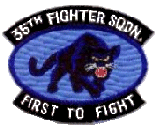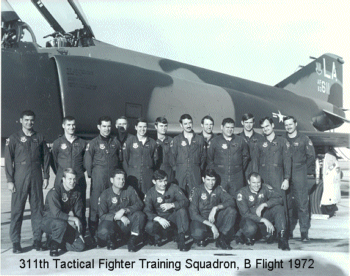Rescue of Roger Locher, Oyster 1 Bravo
by Fred Hastings
As a 1Lt WSO attached to the 523rd TFS on deployment to Udorn Air Base, Thailand, I participated in the mission to rescue downed Oyster 1 Bravo Roger Locher. Upon return I wrote the day’s events up in a journal I maintained during my combat tour.
First Things First: USAF at Its Best
Saturday, 3 June 1972 (1200)
First a recount of Friday’s action. It was the most gratifying mission I’ve ever flown. I was fragged to fly the heavy. I was with Pete Cleary in No. 3 slot as back-up lead. I was pretty apprehensive all during the briefing and preparation. It was the 523rd’s turn to have the inner MiG Cap orbit—the most dangerous one and the one most likely to produce an encounter. We were to orbit in an area about 50 NM north of Hanoi between Phu Yen and Kep airfields and just outside the Hanoi area SAM ring. We were coming from the land route SW of town and had to slip between the SAM rings of Hanoi and Yen Bai to get to the north side. . . .
As it turned out, Maj. Ivy McCoy aborted on the ground for flight control problems. He called Pete and me and gave us the lead and told us to press. All of a sudden, the responsibility was ours. Pete had never led a four-ship MiG cap in RP 6 before, and he was becoming a little apprehensive and awed at the responsibility. We pressed on to the tank and everything went along well. My INS being peaked up, my navigation between the two SAM rings was excellent. Joe Wehrle, who was in the flight for his first RP 6 mission, later described it as “threading the needle.” We assumed our orbit position for 20 minutes as scheduled before egressing the way we came in to refuel again over Laos. Red Crown, the Navy controlling agency, reported negative MiG reaction to the ingress of the air armada.
I said at the beginning that this was the most gratifying mission I ever flew. It was because of the nature of the primary purpose of it all: a SAR (search and rescue mission). I reported earlier that about the 10th of May Bob Lodge and Roger Locher, after shooting two MiG’s and pursuing a third, were themselves shot down by MiG 19 cannon fire. No chutes had been observed by others in the flight and it was expected that a fine crew had been lost.
However, on Thursday, 22 days after that mission, during that day’s heavy, this message was heard over Guard channel: “Any U.S. aircraft, this is Oyster 1 Bravo, can anyone pick me up?” From that moment on, the wheels began to turn to put into action the most dramatic and extensive use of air power in this war in rescuing a downed crewman deep in enemy territory (70 NM northwest of Hanoi). The man who broadcast that message was Roger Locher. For reasons unknown fully then, he was for the first time coming up on his survival radio after 23 days of living in the wilds and practicing escape and evasion techniques.
It was like a man returning from the dead—or about as close as you can come to creating a situation like that in real life. He could not of course be picked up immediately, but he was assured that action would follow as soon as possible. All during the night, 7th AF generals in Saigon worked to put together the biggest master plan and use of air power yet known to rescue one man. [Gen. John Vogt, commander of the 7th Air Force based in Saigon, “shut down the war” and sent 119 aircraft to recover Locher. His rescue was the deepest inside North Vietnam during the entire war and a remarkable example of the power and priorities of Americans when engaged in battle.]
Roger’s location was pinpointed to be about 6 NM southeast of Yen Bai airfield. As a diversionary tactic, the day’s “heavy” strike mission target was to be the airfield. Twenty Ubon strike aircraft were fragged for that task. The MiG-cappers were, as usual, Udorn crews, with the help of Da Nang and NKP and Korat in lesser roles. The King SAR forces, including the Jolly Greens [Jolly Green Giant, nickname for the Sikorsky heavy-lift helicopter] and Sandys [A-1 Skyraider aircraft], were from NKP. They would have the most dangerous mission. They were the low-level slow movers that were tasked with picking up Locher.
As MiG-cappers, we were to protect these slow-movers from MiG attack while they “hung it out” close to the ground deep in enemy territory. After completing our refueling and heading north we monitored Guard and heard the on-scene SAR commander talking to Roger on the ground.
King: Oyster O1B, this is King, come up Guard.
Roger: Go ahead King, this is Oyster O1B.
King: Roger, babes, how are you today?
Roger: I’m fine, healthy. No problems.
King: OK, I got a little question for you. (Referring to Locher’s personal authentication card).
Rog: Go ahead with question.
King: What are Kites?
Rog: Oh, that’s where you drink beer.
King: OK, babes, you’re the man I want to see today. Hang close with your signaling mirror and smokes. We’re coming in.
All crewmembers were required to have three questions on file that only they knew the answer to in case they were shot down. Roger’s “Kites” authentication was not one of his approved three authenticated questions. Because he was on the ground so long, the SAR forces thought his questions might be compromised and lead the rescue forces into a trap. They asked those around Udorn who knew him in his past life to suggest something he might be positively identified by. A fellow graduate of Kansas State said he would surely know about Kites, a beer joint they all frequented.]
Pete and I were elated. It sounded very re-assuring. Both the Sandy’s and Roger’s voices were perfectly clear and calm. It sounded like nothing could go wrong.
And nothing did. We were on station in our MiG cap orbit for 20 minutes while the strike forces bombed the hell out of Yen Bai airfield with “smart bombs” and CBUs, and the SAR forces moved in to pick up Roger. At the end of the 20 minutes we headed out and Disco had us refuel so we could return to the area and escort behind the slow-movers as they moved on south. We were to be the last flight out of North Vietnam.
We RTB’d after everyone was well within his home area, logging 4.0 hours of flying time. We were elated that the SAR had been successful and Roger was safely aboard a Jolly Green en route to Udorn. We victory-rolled our way back home. While we exited from maintenance debrief we observed the two jollies flying overhead, dispensing red smoke in their version of a victory fly-by. They landed near wing headquarters and were greeted by wing and 7th AF generals, who were at Udorn for the day.
None of us got back to the squadron in time to see Roger or to see how he fared his ordeal, but those that did reported him looking in amazingly good shape for 23 days of living in a hostile jungle environment. He had lost weight and had a good beard and moved cautiously, but that was the only noticeable difference. Thus ended a very exciting day—a very gratifying day. I was very proud to be a part of the game plan. In contrast to the normal strike or cap mission, where the value sought in return for “hanging it out” as much as we do is not so obvious (and rather negligible in fact), a search and rescue mission is worthy of giving one’s all in trying to save a fellow crewman. Knowing this, I think we all were a lot calmer in executing our portion of the mission, despite the dangers, then we would normally be.
The O Club had scheduled a welcome back for Roger at 1900 in the main bar. A sheet had been draped with words of welcome (and congrats also for the two guys who got a MiG-19 with cannon fire during the afternoon heavy). The place was packed. Precisely at 1900 someone came running in, saying an ambulance with sirens wailing had just pulled up in front of the club. The door soon opened and to a rising crescendo of applause in walked Roger Locher, clean-shaven, somewhat unsteady and wan of complexion. Everyone was soon standing and clapping wildly, beaming his respect and awe at his fantastic E&E feat and victorious return.
Unfortunately, no one had set up microphones, but he walked right up on the dancer’s dais and with a wave of his hands in a gesture to dull the clapping sound he spoke very softly and very briefly. He was almost inaudible as he thanked everyone for the welcome, asked them to enjoy the beer and champagne, and then quite seriously stated, “And let’s remember those guys up north. They really need it.” And I believe he raised his glass in a toast. He stepped down and immediately was surrounded by his cohorts from the Nickel, as they peppered him with questions he was to be answering many times over for the rest of his days. I remember he was dressed in a party suit. Three great red MiG kill stars had been affixed to the front. He remained in the bar for only a short time, as I’m sure the doctors wanted him back for a good night’s sleep and observation.
It was a historic moment. The importance of the event relegated the celebration for the latest MiG killers to second place—something very rare indeed in a fighter wing. It was a nice feeling, being there, and having contributed to the win.


